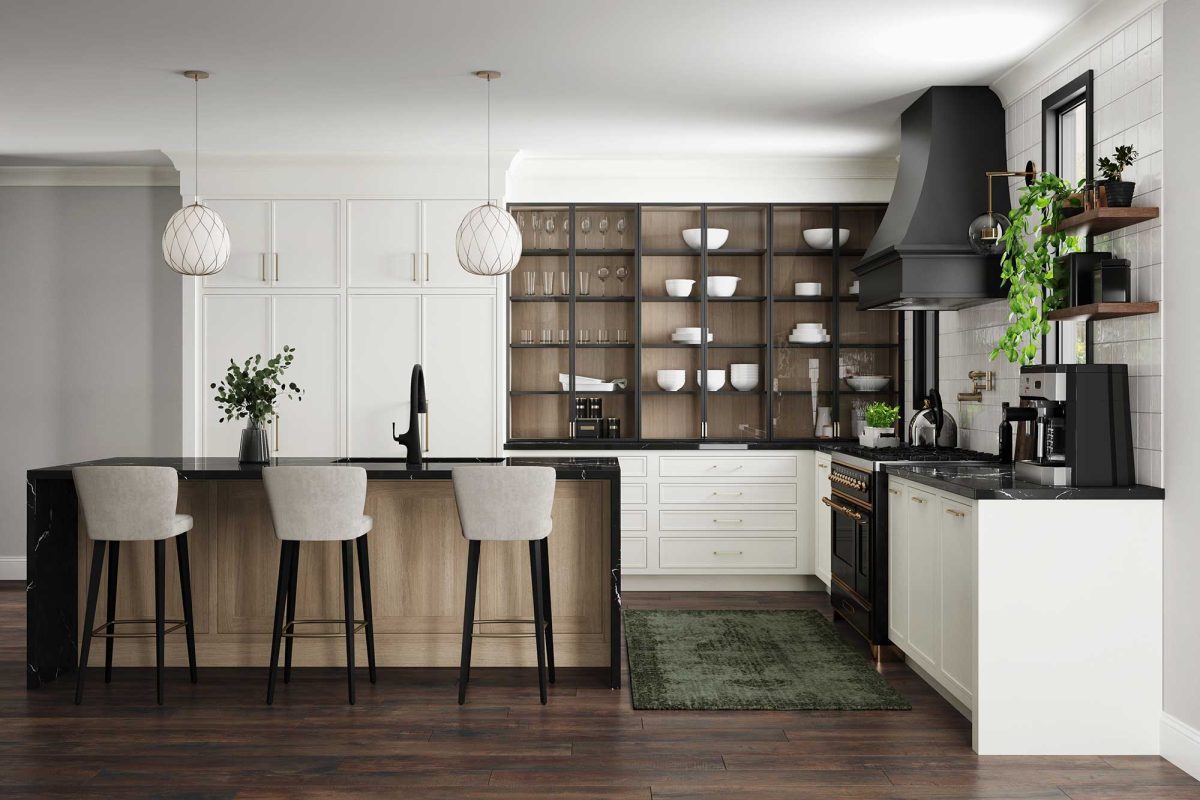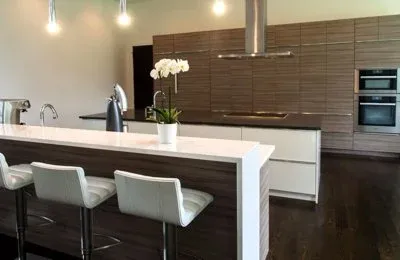In the world of interior design, few elements offer the sleek sophistication of high gloss finishes. More than a surface treatment, it’s a statement—one that turns ordinary cabinetry into a focal point. Popularized by European design houses and now embraced across multiple styles and budgets, the high gloss look reflects light, expands visual space, and adds a crisp, contemporary edge to any room.
Whether you’re outfitting a kitchen, a bathroom, or a custom-built closet, high gloss finishes introduce visual clarity and modern appeal. In compact environments, glossy surfaces amplify light and make spaces feel more expansive—a smart strategy for small spaces where every inch counts. In larger rooms, gloss adds dimension and vibrance, especially when paired with high-contrast textures like matte wood, concrete, or natural stone.
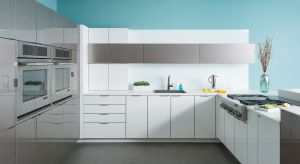
Design Ideas for High Gloss Finishes
One of the best ideas for high gloss cabinetry is in open-concept kitchens, where clean lines and reflective surfaces help unify the space. Consider a high gloss kitchen cabinet finish for modern homes that incorporates a muted color palette—whites, charcoals, or soft taupes—to create a gallery-like atmosphere where the architecture can shine.
For homeowners who want to make a bold design move, go beyond neutrals. Deep navy, forest green, and even glossy black can look striking in a high gloss application, especially when used on an island or wall of floor-to-ceiling cabinets. These affordable high gloss cabinet options for small kitchens offer both aesthetic drama and functional light reflection, maintaining an open and airy feel despite the dark tones.
High gloss finishes can also be a color-blocking tool. Use a durable high gloss finish for custom cabinetry in accent hues like saffron, sky blue, or crimson to highlight open shelving, bar nooks, or appliance garages. These color punches add personality and break up uniformity—a sophisticated design tactic for minimalist spaces.
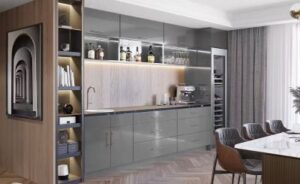
Pairing with Other Materials
Striking the right balance is essential when incorporating high gloss finishes into design. To offset the sleek, reflective surface, mix in materials rich in texture and warmth. Picture the interplay between glossy cabinets and tactile surfaces like rift-cut oak, brushed walnut, or honed stone. These combinations bring depth and a grounded feel to otherwise polished spaces.
High gloss cabinet materials for moisture resistance are particularly valuable in bathrooms and laundry rooms, where both design and durability matter. Glossy white cabinetry against patterned tiles can create a spa-like effect, while darker gloss finishes offer a boutique hotel vibe.
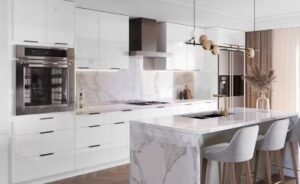
How to Achieve High Gloss Finishes on Wood Cabinets
To get that mirror-smooth surface, there are several options depending on budget and style. The classic technique involves spray-finishing wood cabinetry with a high gloss lacquer—a process that, when professionally executed, delivers a glass-like result. While stunning, lacquer alone isn’t always the most durable choice for high-use areas.
Enter engineered options. Thermoformed cabinet doors layered with premium high gloss finishes deliver both beauty and resilience. These surfaces resist moisture and wear, making them ideal for busy households. Another standout is solid acrylic—a luxury material gaining traction in high-end European kitchens. It offers uniform gloss, UV resistance, and the ability to be refinished, giving it a long product lifespan.
For more cost-conscious projects, high gloss acrylic panels applied over MDF offer the same sheen at a lower price point. Laminates and rigid thermofoils are also evolving, with best high gloss cabinet materials for moisture resistance now including PUR-coated melamine and vinyl-wrapped components.
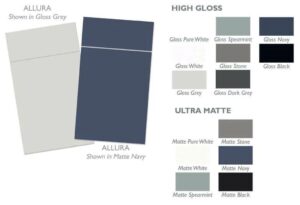
High Gloss Finishes for Cabinets at Laslo Custom Kitchens
Here at Laslo Custom Kitchens, we love the opportunity to design with high gloss finishes—a bold, contemporary choice that instantly elevates any space. Whether you’re looking to create a striking modern kitchen, a sophisticated bathroom vanity, or a built-in storage solution with a sleek edge, high gloss offers a clean, reflective surface that adds depth, dimension, and drama. It plays beautifully with natural light, makes compact spaces feel more expansive, and serves as the perfect contrast to organic textures like wood, stone, and metal.
Our design team has worked with a wide range of high gloss cabinet materials, from polished acrylic panels to thermofoils and premium lacquers. We’ve used gloss finishes in all kinds of applications—crisp white kitchens that feel weightless and bright, deep jewel-toned cabinets that anchor a space with character, and glossy accent elements that provide a pop of visual interest.
We invite you to explore our portfolio and see how we’ve brought high gloss designs to life in real homes. If you’re ready to create a space that shines with sophistication and style, schedule a consultation with us today. We’d love to make your vision—and your cabinetry—shine.
Conclusion
The brilliance of high gloss finishes is more than surface deep. It transforms cabinetry into sculpture—reflective, refined, and full of intention. With today’s wide range of materials, finishes, and color possibilities, homeowners and designers can tailor the look to suit any space. Whether you’re introducing a pop of gloss with accent cabinets or fully committing to a high gloss finish throughout, the result is always the same: design-forward, light-catching, and undeniably modern.
Further Reading
FAQ: High Gloss Finishes for Cabinetry
1. Is a high gloss finish good for kitchen cabinets?
A high gloss finish is an excellent choice for kitchen cabinets, especially in modern or contemporary spaces. It reflects light beautifully, making rooms feel brighter and more open. Ideal for small kitchens or spaces with limited natural light, this finish adds a polished, upscale feel while offering a sleek surface that’s easy to clean and maintain.
2. What are the best materials for high gloss kitchen cabinets?
The best materials for achieving a high gloss finish on kitchen cabinets include lacquered MDF, solid acrylic panels, thermofoil, and laminated surfaces using PUR-coated melamine. Each material offers different levels of reflectivity, durability, and cost. Solid acrylic is ideal for luxury designs, while laminated or thermofoil options provide a similar aesthetic at a more accessible price point.
3. Do high gloss cabinets scratch easily?
High gloss cabinets can show scratches more readily than matte surfaces due to their reflective nature. However, many modern high gloss materials like acrylic panels and quality laminates are engineered with scratch-resistant coatings. Using soft cloths and avoiding abrasive cleaners helps preserve the finish, ensuring the cabinetry remains glossy and beautiful for years with regular care.
4. How do I clean high gloss kitchen cabinets without damaging the finish?
To clean high gloss cabinets safely, use a soft microfiber cloth with a gentle solution of mild dish soap and water. Avoid abrasive sponges, ammonia-based cleaners, or rough cloths, as these can dull or scratch the surface. For fingerprints and smudges, a light buffing with a clean, dry microfiber towel often restores the original shine effortlessly.
5. Are high gloss kitchen cabinets still in style?
Yes—high gloss cabinets remain a popular design choice, especially in urban, minimalist, and modern homes. Their reflective quality enhances light and space, while the clean, streamlined look pairs well with other trends like flat-panel doors, integrated lighting, and mixed material palettes. Gloss finishes also adapt easily to bold colors or timeless neutrals, ensuring lasting visual appeal.
